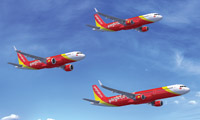News Backgrounder
Singapore’s LCC order spree
Orders at last month’s biennial Singapore Air Show topped US$31 billion, more than triple the business of the previous show in 2012, with low-cost carriers dominating the headlines
March 1st 2014
AirAsia, Lion Air and Jetstar may be the front runners in the Asia-Pacific’s booming budget airline market, but an emerging carrier from Vietnam took centre stage at the Singapore Air Show in February. Read More »
 |
| 'Vietnam will experience passenger growth of 30% year-on-year. That is impressive' |
| Fabrice Bregier President and chief executive Airbus |
Budget carrier, VietJet Air, Vietnam’s first privately-owned airline, ordered 63 A320 jets, at list prices of US$6.4 billion, and took purchase or leasing rights on 38 more of the aircraft type, potentially boosting its current fleet of 11 A320s almost tenfold.
The order was widely anticipated, especially as the carrier had recently launched a joint venture subsidiary in Thailand, Thai VietJet Air, with Thailand’s Kan Air, and announced plans for similar offshoots in Cambodia, Laos, Myanmar and possibly Japan. It also said it is eyeing China, Indonesia and Malaysia for expansion.
Based in Ho Chi Minh city, VietJet began flying in 2011, operating domestic routes, including Da Nang and the nation’s capital, Hanoi and regional services to Bangkok, Seoul and Kunming in China. It has a fleet of 11 leased A320s serving 20 routes.
Airbus president and chief executive, Fabrice Bregier, speaking at a media briefing in at the Singapore show, described VietJet as a “rising star” in Southeast Asia’s low-cost carrier market. He added the airline might add to its order to cater for explosive passenger growth in Vietnam.
| EU and ASEAN sign aviation accord During show week, at a summit organized by the Association of Southeast Asian Nations (ASEAN) and the European Commission (EC), delegates took their aviation cooperation to a new level by negotiating a comprehensive “open skies” air transport agreement. The “open skies” agreement was outlined in a joint declaration adopted in Singapore at the end of a two-day summit that brought together more 300 political and business leaders, including a number of transport ministers from Europe and the Asia-Pacific. At the gathering, the director general and CEO of the International Air Transport Association (IATA), Tony Tyler, pressed delegates to finds ways to enhance aviation’s future connectivity by removing barriers to efficiency, intergrating markets and providing effective regulation. “When we are talking about markets, air transport is unique in its bilateral approach to allocating traffic rights,” Tyler told delegates. “ The Single European Sky delivers tremendous value to European integration. And the ASEAN liberalization plans have similar potential. That potential will only be realized if states implement what they have committed to do.” “If Europe works together with ASEAN to the fullest extent, we can extend the proven benefits of our respective single aviation markets to a much larger inter-regional one,” said EU Transport Commissioner, Siim Kallas. “The summit has created much new momentum for closer cooperation and made a convincing case for embarking on what could be a first aviation agreement in the world between two important blocs of countries like the EU and ASEAN,” he added. The Chairman of the ASEAN Transport Ministers, Sommad Pholsena, said: “Apart from allowing both sides to better capitalize on the opportunities and the capabilities of each other, a bloc-to-bloc agreement would allow ASEAN to learn from the EU’s experience in developing a Single Aviation Market since the 1990s,” said Pholsena, who is the Minister of Public Works and Transport of Laos. ASEAN’s first air transport agreement as a bloc was with China. The Asian bloc also has initiated discussions with Japan and South Korea with a view to concluding similar air transport agreements. |
“In Asia, we expect (passenger traffic) growth year-on-year of close to 6% for the next two decades. In Vietnam, it will be almost 30% year-on-year. This is really impressive,” Bregier said.
Nguyen Thanh Hung, VietJet’s vice chairwoman and CEO, said the carrier had taken 26.2% of the country’s domestic market since it started and carried 4.3 million passengers. The LCC purchase agreement was made up of 42 A320neos, 14 A320ceos, seven A321ceos and 30 purchase rights. The carrier also will lease eight A320 family aircraft. CFM won the engine order for the fleet expansion, in a deal valued at US$800 million.
In other deals at the show, Thailand’s Nok Air, 39.2% owned by Thai Airways International, ordered 15 B737s - eight Next-Generation B737-800s and seven B737 MAX 8s – valued at $1.45 billion. Myanmar’s national carrier, Myanma Airways, agreed to lease up to 10 B737s from lessor, General Electric, worth nearly US$1 billion, the biggest deal yet for a Myanmar carrier.
 |
Irish lessor Amedeo, formerly the Doric Lease Corporation, finalised a contract to buy 20 A380s, in a deal first announced at the 50th Le Bourget Airshow last June.
Regional jet and turboprop manufacturers also had a good show. Embraer and southern India’s six-month old carrier, Air Costa, signed a firm order for 50 E-Jet E2s, with options for 50 more Embraers, powered by Pratt & Whitney engines. The Indian airline, which is based in Vijayawada and flies to Bangalore, Chennai and Hyderabad, ordered 25 E190-E2s and 25 E195-E2s, estimated to be worth $2.94 billion to the Brazilian manufacturer.
ATR wrote contracts for 48 airplanes. Thailand’s Bangkok Airways was confirmed as the previously unnamed customer of six ATR 72-600 turboprops with two options, valued at almost $200 million, and United Arab Emirates’ leasing firm, Dubai Aerospace Enterprise (DAE), signed up for 40 ATR 72-600s, made up of 20 firm orders and 20 options. New ATR client, Spanish carrier, Binter Canarias, will buy six ATR 72-600s.
While the deals were being finalized on the ground, Airbus’ new A350 XWB flight test aircraft performed its first ever airshow flying display at the show. On the way to Singapore it had passed the first 1000 flight test hours milestone for the A350 XWB program following its inaugural MSN1 flight on June 14 last year.
| And briefly … In another major investment in the region, Airbus and aircraft sales and distribution company, Satair, opened the Satair Airbus Singapore Centre (SASC) at Singapore’s Seletar Aerospace Park during show week. The 16,700 sq. m. facility will act as “a new pivot” in the fast growing Asia-Pacific, said the partners. SINGAPORE-BASED aircraft lessor, BOC Aviation, which is 100% owned by the Mainland’s Bank of China, announced during show week that it has chosen Pratt & Whitney”s PW1100G-JM engines for the 15 new A320neos it has ordered and will start accepting for them delivery in 2017. GLOBAL aerospace company, Honeywell, and Indonesia’s GMF Aeroasia, have signed an agreement to maintain Honeywell’s 131-9A Auxiliary Power Units for Garuda Indonesia’s new fleet of 25 A320 aircraft, which will start arriving at the flag carrier this year. CHINA’S Xiamen Airlines extended its relationship with pilot training company, ST Aerospace Academy (STAA), with a contract for the academy to train 60 cadet pilots from the Fujian-based carrier. STAA, the first non-airline affliated flight training organization in Singapore, has trained more than 300 pilots. |